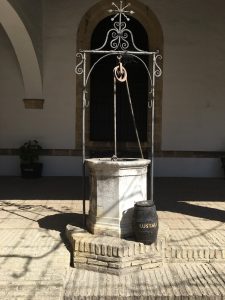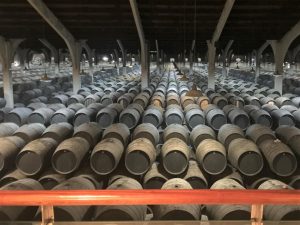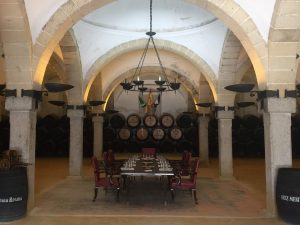 Three birthdays, two wedding anniversaries and a long weekend of celebrating in Spain led to chronic indigestion and border-line alcohol poisoning, but we had a ball. We also got to spend a day in Jerez learning all about sherry.
Three birthdays, two wedding anniversaries and a long weekend of celebrating in Spain led to chronic indigestion and border-line alcohol poisoning, but we had a ball. We also got to spend a day in Jerez learning all about sherry.
Remember that pre-dinner drink our grandparents enjoyed in tiny, egg-cup sized glasses? British wine writer Jancis Robertson once described sherry as a “neglected wine treasure”. In Andalucía, however, it is a drink for all seasons, where it is poured generously into wine glasses and quaffed with your meal.
Sherry is produced in the hot and sunny south-west corner of Spain, in the region around Jerez de la Frontera. Like Champagne and Burgundy it has recently reclaimed its name as belonging only to that drink made in this south-west triangle of Spain. This ‘protected designation of origin status’ was the first of its kind in Spain.
The name Jerez is a derivation of the original Arabic name for the town. Originally known in England as sac from the Spanish word for extraction, saca, the English later anglicized Jerez to form the name of the drink: sherry.
After touring three different bodegas in Jerez, we are now experts on sherry, and yes, I did take notes so that I could share all my new-found knowledge with you. Although, I have to admit, by the third bodega, my ability to analyse the sherries with a modicum of clarity or take intelligible notes was long gone. Lucky, then, that we had a driver and there was no need for any of us to get behind a wheel.
The origins of this particular wine region go way back to more than a thousand years before Christ. It was the Phoenicians who first popped into Spain in 1,100 BC, bringing gifts of grape vines and olive trees. Perhaps not gifts exactly: they set up a flourishing trading post in Cadiz. The Greeks dropped by later to show the locals how to sweeten the wine with unfermented grape syrup. When they claimed the Iberian Peninsula for themselves, around 200 BC, the Romans generously continued the local tradition of wine-making. Settling in for a mere seven centuries, they made quite a successful commercial business of exporting wine throughout the Roman Empire.
Then, in 711 AD the Moors arrived from North Africa. As Muslims, the Moors were teetotal. Nonetheless, they were well-versed in wine-making and also introduced the art of distillation for creating crude fortified wines, a precursor to sherry.
In 966 AD, the somewhat sanctimonious Caliph of Córdoba ordered the destruction of the vineyards. The townspeople caused a riot, declaring that their vineyards also produced raisins to feed the Caliph’s soldiers. The Caliph kindly reconsidered, and his change of heart came in time to spare two-thirds of the vineyards. (Many centuries later, as tastes for sherry has waned, these vineyards would be reduced still further – from 22,00 hectares to a mere 7,000 in the 21st century.)
It took eight hundred years for the Spanish to oust the Moors and reclaim the Iberian Peninsula. They immediately set to work to flex their new-found muscle and spread their territories across the Atlantic, claiming large slices of South America. Cadiz became a primary port for exploration and colonisation, and the ships setting sail for the New World were often better stocked with wine than guns.
set to work to flex their new-found muscle and spread their territories across the Atlantic, claiming large slices of South America. Cadiz became a primary port for exploration and colonisation, and the ships setting sail for the New World were often better stocked with wine than guns.
The wines from Jerez had, in the meantime, had become popular abroad. England was particularly fond of the Spanish ‘sack,’ as it was known, at least till the English broke with Rome over Henry VIII’s divorce from his Spanish Queen Katherine of Aragon. Such an insult to the Spanish King, the Pope and the Roman Catholic Church made the English merchants personae non gratae on the Iberian Peninsula for several decades.
In 1587, however, Drake sacked Cadiz and destroyed the Spanish Armada. He claimed 2,900 barrels of sherry as a portion of his winner’s prize and proudly presented it to Queen Elizabeth’s Court. The Queen loved it, and thanks to such royal favour, sherry once again became popular in England. Even Shakespeare thought it worth a brief acknowledgement. In Henry IV, Falstaff states dramatically that ‘if I had a thousand sons… I would teach them… to forswear thin potations and addict themselves to sack.’ Sack, or sherry, would gain such recognition in England, that many of the Jerez cellars would later be founded by British companies – does Bristol Cream Sherry ring any bells? By the end of the 16th century, Jerez wines were again being exported across Europe and were considered by admirers to be the world’s finest wine.
The fortification of wine into sherry seems to have been something of a lucky accident. During the nineteenth century, wines from Jerez began to be upstaged by Porto’s fortified wines. Spanish merchants were left with excess stock that they could only move in small amounts. The solera blending system developed – I’ll give a more detailed explanation of this later – to top up little used wine barrels. It was soon discovered that this had a remarkable effect on the flavour and aroma the wines, not to mention creating a more consistent profile. Adding brandy, as the Portuguese did to strengthen their ports, also proved a good tip, and oloroso came into being. Thus, centuries of colonisation and exploratory vinification have resulted in a wide variety of splendid sherries.
Enough history. Let’s get on with the tasting!
 Our first stop was to Bodegas Lustau, which was established in the late 19th century by José Berdejo. In the 1940s, he was joined by his son-in-law Emilio Lustau, who expanded the business considerably. Lustau is now one of the world’s most reliable sherry brands, easily recognisable by its black, smooth-shouldered bottles. It also claims to produce the largest range of sherries. I had certainly never realized there were so many different types.
Our first stop was to Bodegas Lustau, which was established in the late 19th century by José Berdejo. In the 1940s, he was joined by his son-in-law Emilio Lustau, who expanded the business considerably. Lustau is now one of the world’s most reliable sherry brands, easily recognisable by its black, smooth-shouldered bottles. It also claims to produce the largest range of sherries. I had certainly never realized there were so many different types.
Driving into the centre of the city, we were met by our guide, a long-term English expatriate, Together, we entered the cobbled courtyard behind the grand front gates. Inside, we wandered through Cathedral-like halls where some 2000 black wooden barrels were stacked three high in rows that seemed to stretch for miles. The barrels are painted black so that leaks can be seen more easily. Unlike winemakers, sherry producers are keen to avoid wood flavours in the wine, so a new barrel will be used to ferment wine or age whisky for up to 10 years to reduce the woodiness, before it is used for ageing sherry, especially the more delicate varieties. The sherry might then remain in the barrels for anything up to 30 years, and the barrel itself may be in use for a century or more. Bodegas will therefore stockpile old staves and hoops should the barrels get damaged.
It is necessary to keep the barrels cool in this hot climate, so the ceilings rise fourteen metres high, and the walls of the buildings are extra thick. It is also important to keep the air circulating, so there is no glass in the windows, only shutters, which are closed when the ‘levant’ (hot wind) blows through. The floor consists of locally quarried sand that is packed down and watered weekly (more often in summer) which creates natural air conditioning and humidity.
The first sherry we meet is fino, which is made from palomino grapes. Palomino makes up about 95% of the region’s  harvest, as it is used for most sherry styles, including amontillado and oloroso. Two other grape varieties – Pedro Ximenez and Moscatel – are used for sweeter sherries that are often preferred in northern Europe over the drier styles.
harvest, as it is used for most sherry styles, including amontillado and oloroso. Two other grape varieties – Pedro Ximenez and Moscatel – are used for sweeter sherries that are often preferred in northern Europe over the drier styles.
Harvested in August, the grapes are fermented into a base white wine and then fortified over winter. During fermentation, the barrels are not filled to the top, allowing air and space for a layer of natural yeast to form on the surface of the wine that protects it from oxidisation. Barrels can therefore be uncorked, to check the development of the sherry.
Making sherry involves a system known as solera, which means floor in Spanish. Stacked three barrels high, bottling occurs from the bottom up. As each lower barrel is partially emptied, it is topped up from the barrel – or nursery – above, in a cascade-like effect that also feeds the yeasts with fresh nutrients. This method of blending ensures every bottle tastes the same. Also, as the different batches mingle, the resulting sherry becomes more mature, but at the same time adds a freshness to this older wine. Thus, sherry bottles will not usually carry a specific vintage year and can contain a small proportion of very old wine.
After fermentation, the base wine is fortified with grape spirit, raising their final alcohol content from 15.5 – 18% depending on the style. Those at the higher end of the alcohol chain do not develop yeast and therefore oxidise a little as they age, giving them a darker colour. As the fortification takes place after fermentation, most sherries are initially very dry, and any sweetness is added later. In contrast, port is fortified halfway through its fermentation, which stops the process so that not all the sugar is turned into alcohol.
 The barrels, originally made from chestnut, are now made from white American oak, the older the better, to ensure minimum oak influence. For the sweeter sherries, the need to keep the barrels cool is not so significant. Natural sugars are increased with one of two methods: either late harvesting or drying the grapes in the sun after picking. Each style of sherry therefore develops different characteristics.
The barrels, originally made from chestnut, are now made from white American oak, the older the better, to ensure minimum oak influence. For the sweeter sherries, the need to keep the barrels cool is not so significant. Natural sugars are increased with one of two methods: either late harvesting or drying the grapes in the sun after picking. Each style of sherry therefore develops different characteristics.
Fino can be incredibly, tongue-curlingly dry, and sometimes almost salty. There is an aroma of sandalwood and honey. Puerto fino smells like popcorn and tastes like hot buttered toast. It is a real mouthful of flavour.
Amontillado, a fortified fino, goes through a double aging process that makes it much more complex. It can be as dry as fino but it smells – and looks – like caramel. With a definite nutty flavour (think hazelnuts) it goes well with pecorino cheese or wild mushrooms. An Italian friend immediately planned a dinner with mushroom risotto.
Olorosso, has a strong whiff of the chemical, combined with an unexpected woodiness in both aroma and flavour. Our guide recommended a strong cheese or osso buco to accompany it.
At the sweeter end of the scale, the sherries are dark, and taste more like tokay without a tokay’s long finish. Think Christmas pudding, plums, brandy, golden syrup, liquid gold…
These sweeter sherries pour like olive oil, with a viscosity that gives it ‘legs’ – a thick trail of wine that seems to flow down the inside of the glass like honey. These have proved much more popular than the dry sherries among northern European drinkers, although personally, I prefer the drier styles.
The second bodegas we visited was also near the centre of Jerez. Diez-Merito was established in the 19th century. It stayed with the family until 1979. In 2016, it was bought by the Espinosa family, who added new vineyards, and established the cellar door in a lovely old building that dates to 1760. Our guide is a tall, lean Spanish woman who walks and talks at high speed in a thick Spanish accent, taking us through the details of sherry production. By now, as I hear much of this information for the second time, I am starting to feel quite knowledgeable, and nod encouragingly even at what I can’t quite follow. She also proves her point that sherry tastes better with food by sitting us at a vast refectory table and providing plates of tapas to accompany our sherry tasting. Relieved to be off our feet, we cheerfully try more sherry and munch through a selection cheese and meats.
Our final visit was to the Estévez Bodegas y Viñedos. This is a vast, custom built and relatively new bodega on the outskirts of town, although the family has been making sherry since the late nineteenth century. Unlike the previous bodegas, this one uses state of the art technology, and has acquired many other labels over the years.
The entrance is grandiose, the walls lined with family portraits. Our guide is Danish and well-informed. We follow her through cathedral halls where barrels are stacked to the horizon. By now, my taste buds were exhausted, and I really didn’t feel like drinking another drop of sherry. Luckily there were other forms of entertainment here. We were invited to take a peep at the horse stud out the back: beautiful glossy black stallions, tall and temperamental, and the friendlier mares and foals, soft as satin. The Estévez family have also gathered an awe-inspiring collection of mostly Spanish art. This included the entire collection of Picasso’s sketches and a Miro, displayed on a mezzanine gallery above the banqueting hall, where we wandered, agog, unwilling to drag ourselves away.
An outstanding day was finished off with a terrific dinner, and of course more wine. Overindulged? Totally!
